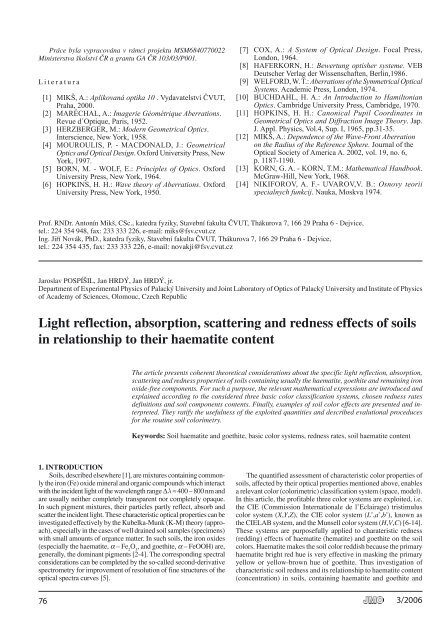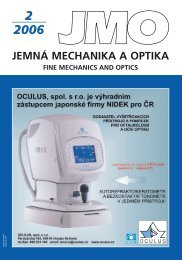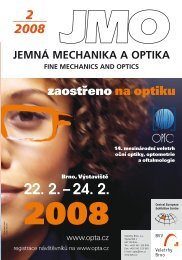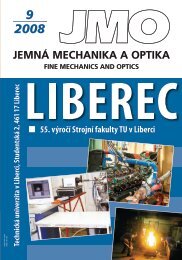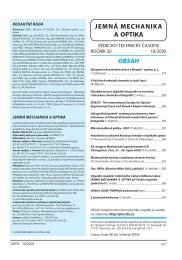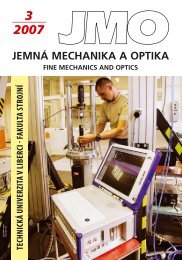You also want an ePaper? Increase the reach of your titles
YUMPU automatically turns print PDFs into web optimized ePapers that Google loves.
Práce byla vypracována v rámci projektu MSM6840770022<br />
Ministerstva školství ČR a grantu GA ČR 103/03/P001.<br />
Literatura<br />
[1] MIKŠ, A.: Aplikovaná <strong>optika</strong> 10 . Vydavatelství ČVUT,<br />
Praha, 2000.<br />
[2] MARÉCHAL, A.: Imagerie Géométrique Aberrations.<br />
Revue d´Optique, Paris, 1952.<br />
[3] HERZBERGER, M.: Modern Geometrical Optics.<br />
Interscience, New York, 1958.<br />
[4] MOUROULIS, P. - MACDONALD, J.: Geometrical<br />
Optics and Optical Design. Oxford University Press, New<br />
York, 1997.<br />
[5] BORN, M. - WOLF, E.: Principles of Optics. Oxford<br />
University Press, New York, 1964.<br />
[6] HOPKINS, H. H.: Wave theory of Aberrations. Oxford<br />
University Press, New York, 1950.<br />
��<br />
[7] COX, A.: A System of Optical Design. Focal Press,<br />
London, 1964.<br />
[8] HAFERKORN, H.: Bewertung optisher systeme. VEB<br />
Deutscher Verlag der Wissenschaften, Berlin,1986.<br />
[9] WELFORD, W. T.: Aberrations of the Symmetrical Optical<br />
Systems. Academic Press, London, 1974.<br />
[10] BUCHDAHL, H. A.: An Introduction to Hamiltonian<br />
Optics. Cambridge University Press, Cambridge, 1970.<br />
[11] HOPKINS, H. H.: Canonical Pupil Coordinates in<br />
Geometrical Optics and Diffraction Image Theory. Jap.<br />
J. Appl. Physics, Vol.4, Sup. I, 1965, pp.31-35.<br />
[12] MIKŠ, A.: Dependence of the Wave-Front Aberration<br />
on the Radius of the Reference Sphere. Journal of the<br />
Optical Society of America A. 2002, vol. 19, no. 6,<br />
p. 1187-1190.<br />
[13] KORN, G. A. - KORN, T.M.: Mathematical Handbook.<br />
McGraw-Hill, New York, 1968.<br />
[14] NIKIFOROV, A. F.- UVAROV,V. B.: Osnovy teorii<br />
specialnych funkcij. Nauka, Moskva 1974.<br />
Prof. RNDr. Antonín Mikš, CSc., katedra fyziky, Stavební fakulta ČVUT, Thákurova 7, 166 29 Praha 6 - Dejvice,<br />
tel.: 224 354 948, fax: 233 333 226, e-mail: miks@fsv.cvut.cz<br />
Ing. Jiří Novák, PhD., katedra fyziky, Stavební fakulta ČVUT, Thákurova 7, 166 29 Praha 6 - Dejvice,<br />
tel.: 224 354 435, fax: 233 333 226, e-mail: novakji@fsv.cvut.cz<br />
Jaroslav POSPÍŠIL, Jan HRDÝ, Jan HRDÝ, jr.<br />
Department of Experimental Physics of Palacký University and Joint Laboratory of Optics of Palacký University and Institute of Physics<br />
of Academy of Sciences, Olomouc, Czech Republic<br />
Light reflection, absorption, scattering and redness effects of soils<br />
in relationship to their haematite content<br />
The article presents coherent theoretical considerations about the specific light reflection, absorption,<br />
scattering and redness properties of soils containing usually the haematite, goethite and remaining iron<br />
oxide-free components. For such a purpose, the relevant mathematical expressions are introduced and<br />
explained according to the considered three basic color classification systems, chosen redness rates<br />
definitions and soil components contents. Finally, examples of soil color effects are presented and interpreted.<br />
They ratify the usefulness of the exploited quantities and described evalutional proceduces<br />
for the routine soil colorimetry.<br />
1. INTRODUCTION<br />
Soils, described elsewhere [1], are mixtures containing commonly<br />
the iron (Fe) oxide mineral and organic compounds which interact<br />
with the incident light of the wavelength range Dλ » 400 – 800 nm and<br />
are usually neither completely transparent nor completely opaque.<br />
In such pigment mixtures, their particles partly reflect, absorb and<br />
scatter the incident light. These characteristic optical properties can be<br />
investigated effectively by the Kubelka-Munk (K-M) theory (approach),<br />
especially in the cases of well drained soil samples (specimens)<br />
with small amounts of organce matter. In such soils, the iron oxides<br />
(especially the haematite, a – Fe 2 O 3 , and goethite, a – FeOOH) are,<br />
generally, the dominant pigments [2-4]. The corresponding spectral<br />
considerations can be completed by the so-called second-derivative<br />
spectrometry for improvement of resolution of fine structures of the<br />
optical spectra curves [5].<br />
Keywords: Soil haematite and goethite, basic color systems, redness rates, soil haematite content<br />
The quantified assessment of characteristic color properties of<br />
soils, affected by their optical properties mentioned above, enables<br />
a relevant color (colorimetric) classification system (space, model).<br />
In this article, the profitable three color systems are exploited, i.e.<br />
the CIE (Commission Internationale de l’Eclairage) tristimulus<br />
color system (X,Y,Z), the CIE color system (L * ,a * ,b * ), known as<br />
the CIELAB system, and the Munsell color system (H,V,C) [6-14].<br />
These systems are purposefully applied to charateristic redness<br />
(redding) effects of haematite (hematite) and goethite on the soil<br />
colors. Haematite makes the soil color reddish because the primary<br />
haematite bright red hue is very effective in masking the primary<br />
yellow or yellow-brown hue of goethite. Thus investigation of<br />
characteristic soil redness and its relationship to haematite content<br />
(concentration) in soils, containing haematite and goethite and<br />
������


